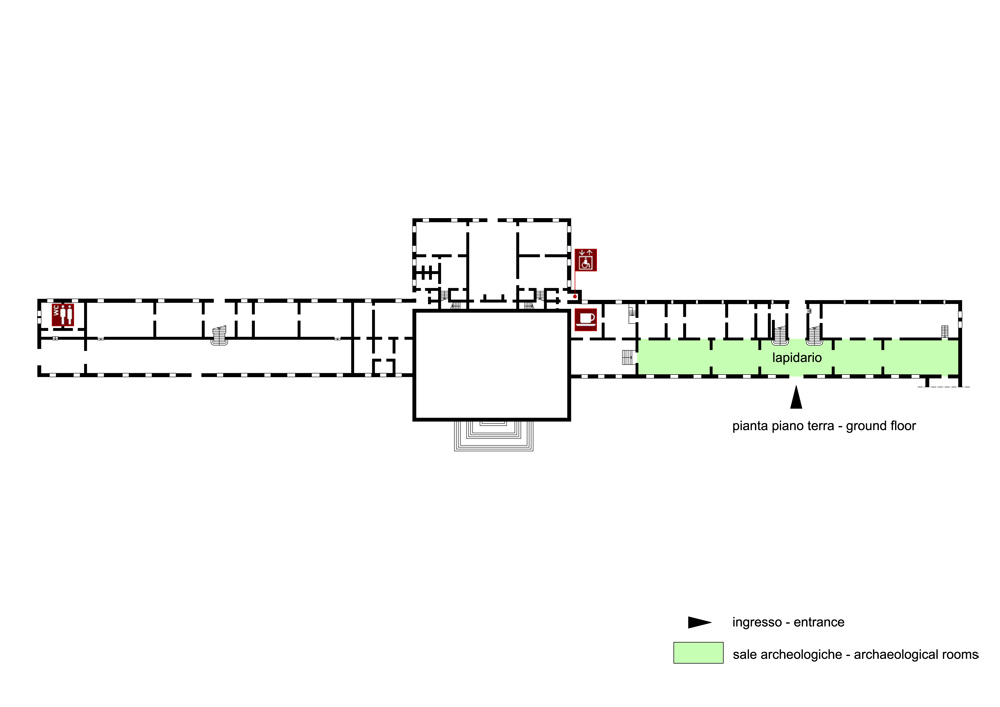| Via Camerini 1 - 35016 Piazzola sul Brenta (PD)
Tel. 049 5590238 - Fax 049 9619182 |
|
|
Summary
The imposing Villa Contarini, gives, on its southern side, onto the evocative semicircular square, which is at the core of the life in the municipality of Piazzola sul Brenta. The most important part of the building is the fourteenth century castle belonged to the Carraresi family, which in the sixteenth century was then sold to the Contarini family of Venice, who decided to renovate and enlarge it. In one of its lateral wings, namely the eastern one, it is possible to see interesting Greek and Latin epigraphic material, which was collected over the years by the noble Venetian and Paduan families.Collection history
The items displayed come from the former “Naniano” museum, established in the Villa Pagani in Legnaro approximately in 1700 and then moved to Villa Contarini in the early 20th century by the member of the Contarini family themselves, who at the time were the owners of the villa. Unfortunately part of the collection went lost during the 20th century as after the second world war the Villa fell into decay. Yet thanks to the patient restoration, renovation and cataloguing work carried out in the 70’s, most of the material was recovered and suitably arranged in the expositive plan, which can be seen still today.
|
 |  |
Lapidarium The collection includes inscribed gravestones, fragments of architectural decorations, commemorative, votive, sepulchral and public inscriptions coming different areas and periods. The first twenty epigraphs come from Greece, in particular from Corfu and other Ionic islands and were taken to Venice during the hegemony of the Most Serene Republic of Venice in the eastern world. The most significant items are the fragment of the base of a statue of Hadrian from Abea (in Messenia), a bilingual funerary inscription (in Greek and Latin) from Leukadià, placed on the grave of Aulo Cossinio Philocrates, which bears witness to the phase of the Roman conquest, a marble stele, on which a decree by the Athenian assembly of the 2nd cent. B.C. is engraved, and finally a large quadrangular base, which had to possibly hold the female statue representing a Greek priestess turned to the imperial cult.
The Latin inscriptions can be mainly divided into three categories: the sepulchral, the commemorative and the votive ones. The first group includes a remarkable amount of fragments of tablets and steles, which display a rich decoration of small pediments, acroteria and bands, mainly coming from Dalmatia; among the commemorative inscriptions, particularly noteworthy are the three inscriptions devoted to Antoninus Pius (138 A.D.), Giulia Domna (wife of Septimius Severus, 193 A.D.) and Marcus Aurelius (166 A.D.) respectively, which were imported from Patras and from Croatia. The last group includes numerous quadrangular altars offered as votive gifts to Mercury and the Nymphs. There are only two exceptions that cannot be classified in these typological categories: a fragment of a boundary stone and some trachyte pipes found in the property of the Camerini family in Legnaro, which are very likely to have been part of a Roman aqueduct. |
|
Visiting
Admission: Negli orari di apertura;
Ticket: No;
 School access School access
 Disabled access Disabled access
|
Recommended tour time (minutes): 30 |
|
Services for visitors
 Toilet Toilet Parking Parking Bookshop Bookshop Bar/Restaurant Bar/Restaurant |
Educational Services
 Guide a stampa
Brochure Guide a stampa
BrochureItalian  Information boards Information boardsItalian  Captions under exhibits Captions under exhibitsItalian  Guided Tours Guided Tours |
Bibliography
| Bassignano M.S., Ghinatti F. 1973, Museo Lapidario greco-latino, in Guida alla visita di Villa Simes già Contarini XVI secolo, a cura di Semenzato C., Milano. |
| Bonetto J. 2009, Veneto (Archeologia delle Regioni d'Italia), Roma, pp. 410. |